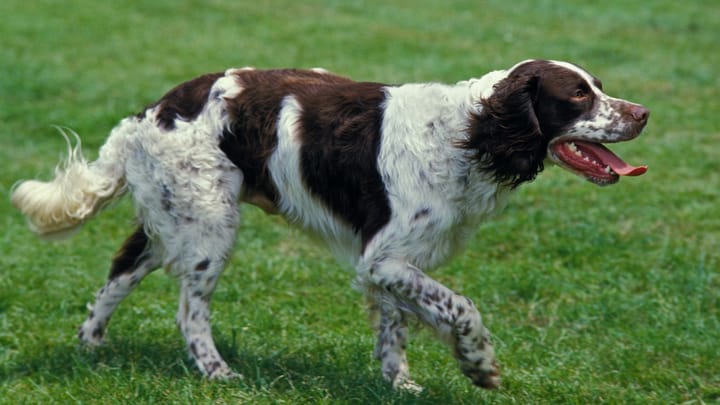French Spaniel
Other names : Epagneul Français, French Setter, Canadian Setter

The French Spaniel is a graceful, athletic, and very intelligent dog. They bare a striking resemblance to the English Springer Spaniel and have many of the same character traits. Bred as a working dog, they thrive off human company and love to feel part of the pack. This friendly dog is always eager to please and requires up to two hours of exercise every day.
|
Life expectancy |
The French Spaniel has a life expectancy of between 12 and 14 years |
|
Temperament |
|
|
Size |
Medium
|
|
Adult size |
Female
Between 21 and 24 in
Male
Between 22 and 25 in
|
|
Adult weight |
Female
Between 53 and 57 lb
Male
Between 53 and 57 lb
|
|
Coat colour
Brown (cinnamon to dark liver) and white. Speckled or roan. |
White Brown |
|
Type of coat
Long to mid-length. Flat or slightly wavy. Wavy on the ears and tail. |
Long Wavy |
|
Eye colour
From cinnamon to brown. |
Brown
|
French Spaniels are known for having large litters. New mums can produce as many as 8 pups. These guys need lots and lots of exercise, and a stroll around the block won’t do. They need to run free and explore.
More details about the French Spaniel
French Spaniel: Origins and history
The French Spaniel can be traced all the way back to Gaston Phoebus’s "Book of Hunting" in the 13th century. They were popular hunting dogs used to track and retrieve small game. Prized for their stamina, loyalty, and persistent nature, their numbers continued to grow until the early 20th century. Then, as more small villages turned into industrial towns, there was less demand for hunting dogs. Thankfully, French Spaniel clubs started to spring up in the UK, USA, and Canada during the middle of the century. They helped raise awareness of the breed and played an instrumental part in saving these very special animals.
Physical characteristics of the French Spaniel
The French Spaniel is a medium-sized, well proportioned dog. They look a little like the Brittany, but are up to 10cm taller. They have a sturdy, athletic physique with powerful hindquarters. French Spaniels tend to have flat silky coats which become wavy around the ears, underbelly, and tail, and they have a sweet expression in their oval eyes.
FCI classification of the French Spaniel
-
Group 7 - Pointing Dogs
-
Section 1 : Continental Pointing Dogs
French Spaniel: Characteristics
French Spaniel: Behaviour
Training a French Spaniel
French Spaniels are fairly easy to train, but they do have some very specific requirements. Training needs to be fun and engaging. Keep the sessions short, kind, and consistent. 10-15 minutes a day is ideal.
French Spaniel: Lifestyle
Breed compatibility French Spaniel
French Spaniel: Purchase price
We do not have enough data to set an average price. Looking after a dog of this size typically costs between £90 to £120 a month, including food, medical/insurance, and incidental expenses.
French Spaniel: Shedding
Average
Moderate shedder.
French Spaniel: Grooming
The maintenance of the French Spaniel is not tedious but must be regular to avoid knots or parasites. Their large ears should be cleaned regularly to prevent infection, especially after playing in water.
French Spaniel: Health
Thanks to centuries of careful breeding, the French Spaniel is a very healthy dog with an average life expectancy of 13 years.
They’re not the biggest or strongest, but they’re definitely one of the most robust breeds. They’re sturdy, athletic, and have loads of stamina.
Spaniels have no problems coping with the average British summer, but you should always exercise them during the coolest parts of the day. It will stop them from overheating.
These dogs were designed for the great outdoors, meaning they can cope with cold weather very well.
High-energy breeds like the Spaniel tend to maintain a healthy body weight. Any excess weight will only come from overfeeding, a lack of exercise, or certain health issues.
- Hip Dysplasia
- Arthritis
- Acral mutilation
- Analgesia
- Cataract
- Entropion
- Dislocation of the nictitating gland
- Eczema
- Ear infections



